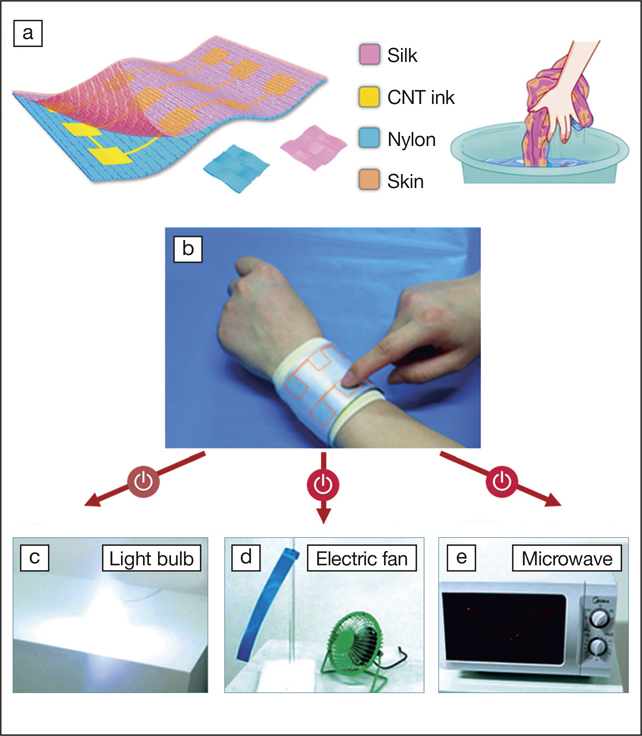Wearable electronics represents a family of smart devices that can be worn as accessories or implants, but are yet to be widely seen in day-to-day usage partly due to their incompatibility with water. Now Congju Li and his colleagues from the Chinese Academy of Sciences have designed wearable electronics that address the washability challenge. Their launderable tribo-sensor can be self-powered through the triboelectric effect and can remotely switch several home appliances on and off. This work was recently published in ACS Nano (doi:10.1021/acsnano.8b02477).

(a) Schematic showing the structure of the developed tribo-sensor. (b) Wearable tribo-sensor prototype switches on and off (c) a light bulb, (d) an electric fan, and (e) a microwave oven. CNT is carbon nanotube. Credit: American Chemical Society.
The tribo-sensor consists of three functional layers. The bottom Nylon layer serves as a flexible substrate that can be woven into clothes. The middle layer, consisting of carbon nanotube (CNT) patterns screen-printed onto the Nylon layer, functions as electric circuits. The top silk layer is a friction layer that generates and maintains electrostatic charge. To improve the adhesion between the CNT circuits and the substrate, the researchers added polyurethane to the CNT ink. Polyurethane , with its abundant amino groups, can firmly bind CNTs onto the Nylon fabric through hydrogen bonds, preventing the CNT electric circuits from detaching by washing.
The self-powering mechanism of the tribo-sensor is associated with the triboelectric effect. After frictional contact between skin and the sensor, the CNT and silk layers accumulate equal amounts of positive and negative electrostatic charge, respectively. Afterward, any action (e.g., touch or rub) that changes the gap between the middle and the top layers will generate electricity to power the sensor.
According to Li, the motivation for this work is to “integrate human-machine interfaces with clothes, which would allow convenient remote control of electronics.” The researchers demonstrated how the tribo-sensor wirelessly powered three typical home appliances: a light bulb, an electric fan, and a microwave oven. The research team first incorporated the sensor as a remote controller into a wireless home control system. Touching the sensor results in a voltage output that is transmitted as electromagnetic pulse signals. These signals can then be received by the terminal electronics to turn the appliance on or off. “Imagine on a cold winter morning, you could easily turn on your TV and microwave your breakfast without leaving your warm bed,” Li says.
Jun Chen of Stanford University, who was not involved in this work, says, “The screen-printed washable tribo-sensor consisting of electronic textiles for human–machine interfacing is a nice demonstration of how triboelectric nanogenerators (TENGs) can be involved in the Internet of Things. Essentially, with advantageous features including air permeability, cost-effectiveness, and washability, this electronic textile-based tribo-sensor may open new ways to apply TENGs to multifunctional wearable electronic devices.”


